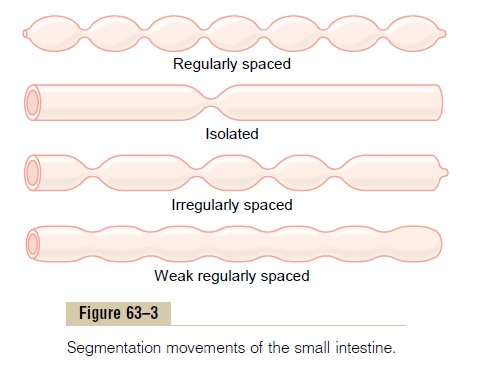Chapter: Medical Physiology: Propulsion and Mixing of Food in the Alimentary Tract
Mixing Contractions (Segmentation Contractions) - Movements of the Small Intestine

Mixing Contractions (Segmentation Contractions)
When a portion of the small intestine becomes dis-tended with chyme, stretching of the intestinal wall elicits localized concentric contractions spaced at intervals along the intestine and lasting a fraction of a minute.
The contractions cause “segmentation” of the small intestine, as shown in Figure 63–3. That is, they divide the intestine into spaced segments that have the appearance of a chain of sausages. As one set of seg-mentation contractions relaxes, a new set often begins, but the contractions this time occur mainly at new points between the previous contractions. Therefore, the segmentation contractions “chop” the chyme two to three times per minute, in this way promoting pro-gressive mixing of the food with secretions of the small intestine.

The maximum frequency of the segmentation con-tractions in the small intestine is determined by the frequency of electrical slow waves in the intestinal wall, which is the basic electrical rhythm described. Because this frequency normally is not over 12 per minute in the duodenum and proximal jejunum, the maximum frequency of the segmentation contractions in these areas is also about 12 per minute, but this occurs only under extreme conditions of stim-ulation. In the terminal ileum, the maximum frequency is usually 8 to 9 contractions per minute.
The segmentation contractions become exceedingly weak when the excitatory activity of the enteric nervous system is blocked by the drug atropine. There-fore, even though it is the slow waves in the smooth muscle itself that cause the segmentation contractions, these contractions are not effective without back-ground excitation mainly from the myenteric nerve plexus.
Related Topics